A bottom seeking fly for pike, bass, cod, pike perch, sea trout - even bonefish and many other fish.

From thought over drawing to a finished fly
One of the most satisfying aspects of fly tying is in my opinion the chance to design your own fly.
I have come up with many ideas, tied hundreds of flies inspired by them, but mostly thrown them away after having carried them in my fly boxes for some time - either because they were totally unused or because they were unproductive.

The original sketch, materials list and tying instruction.

One of the first flies tied after the above pattern. Orange belly, yellow eyes and nutria zonker strip.
Etymology
The name of this fly is The Kluting (pronounced 'clooting'). It might seem Danish to you, but it's not. There is a connection to a Danish word, though. Sculpin is 'kutling' (almost pronounced 'cutling') in Danish. Well, a simple typo made this 'kluting', and the fly was baptized. Too easy? What the h... How did the Beatles wind up with their name anyway?
An idea
Recently I got the idea that I wanted a new type of bottom fly - some kind of sculpin like imitation, with weight, clearly visible eyes and materials with a lot of motion. Of course I have lots of patterns like that already, but who can stand in the way of creativity? I dug out some paper and a pen, and drew the sketch that you see here - a variation of the basic zonker. As with most of my fly ideas, I had a pretty good idea of the looks of the fly, and I also had some general ideas of the materials I wanted to use. These ideas I also listed on the paper. I also knew the tying sequence of this fairly simple fly, and noted that too.
1st revision
Already while drawing I made the first revisions of the fly. The first version had a fat head made by brushing up a ball of dubbing. I revised that to a head spun by deer hair which is one of my favorite materials. The other major change was turning the hook upside down. This would gain me at least a pair of advantages: getting the hook away from the bottom and hiding the hook point. My experience also tells me that these zonkers have a common problem: the tail often slips down and around the hook bend, and this will effect the appearance and action of the fly. There are a few ways to avoid this. One is to shorten the tail, another to support the tail with a loop of mono, but a third one is to turn the hook upside down. The hook shank penetrating the skin strip will prevent the tail from getting caught in the bend.
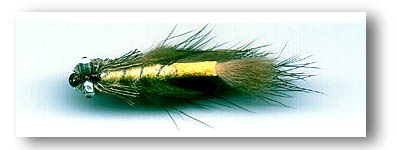
A light belly version seen from the ventral side
1st tie
I tied the first five flies the same evening that I made the drawing. These were fine, except for one thing. On the original drawing I had a pair of breast fins made from poly yarn. These definately didn't work. They did not look at all like fins, and certainly added a lot of clumsiness to the fly. After a couple of tries with breast fins, I just omitted them on the following three, and the fly still looked good.
Everything acted as I had expected, except for two little things: the rib was a bit difficult to turn the first couple of rounds as the hook tip seemed to be in the way more than is usually the case with zonkers. The other things was more positive: the zonker strip hid the hook point more than I had imagined. This ment a better imitation (in my eyes) but probably also less bottom snags.

The 2nd version of the fly was larger and more colorful
2nd tie
I didn't get a chance to fish the fly before I got around to tie it again. This was the evening before leaving for a trip to catch winter cold sea trout in the south west part of the island Seeland where I live.
Now, in the winter the trout tend to be very slow, and often only a colorful fly will get them moving. This is often obtained using flies like the Glitter Shrimp or colorful versions of well known patterns. That inspired me to tie a colorful version of this yet unnamed fly.
The color came from three materials: orange dubbing, a red rabbit zonker strip and orange deer hair. I also used a larger hook to get an even more visible fly. Both this version and the smaller, naturally colored version are quite heavy, but with a little ease, a short stiff leader and some deliberately slow casting movements they will cast easily on a 6 wt.
I did so - cast intensively with both flies that cold day on the Danish coast, but caught nothing... but that's a whole other story.
Materials
| Hook | Tiemco TMC 700 size 2-4 |
| Thread | Brown |
| Rib | Oval medium silver tinsel |
| Body | Almost any dubbing, I use Scintilla light tan or orange |
| Tail/back | Nutria zonker strip |
| Eyes | Bestco painted dumbbell |
| Head | Natural deer hair |
Materials bright version
| Hook | Kamasan B800 size 2-4 |
| Thread | Orange |
| Rib | Oval medium silver tinsel |
| Body | Almost any orange dubbing, I use Scintilla |
| Tail/back | Red rabbit zonker strip |
| Eyes | Bestco painted dumbbell |
| Head | Orange deer hair |
Tying instructions
- Tie on the hook upside down
- Start the thread just over the hook bend. Actually under when the hook is upside down
- Tie in the silver tinsel under the bend. Actually over when the hook is upside down
- Dub two thirds of the body with an even cylindrical layer of dubbing
- Prepare a medium narrow zonker strip of fur
- Measure the strip for length. Make note of the position where the hook will penetrate the skin, like poking it with a bodkin or marking it with a pencil (1st drawing).
- Punch the hook through the skin in this spot (2nd drawing)
- Pull the skin tightly up against the body (3rd drawing)
- Tie down the skin in front of the body (also 3rd drawing)
- Wind the ribbing through the skin in 4-5 open, but tight turns (4th drawing)
- Tie down and cut surplus
- Tie in the eyes on top of the hook shank. Actually under the hook when the hook is upside down (5th drawing)
- Prepare some deer hair. There's no need to stack it
- Flare the deer over the eyes. Keep it under the hook shank. Actually over the hook when the hook is upside down (6th drawing)
- Tie in one more bunch if needed
- Add several drops of varnish on the bases of the hair
- Let dry
- Trim the deer hair if needed
- Log in to post comments

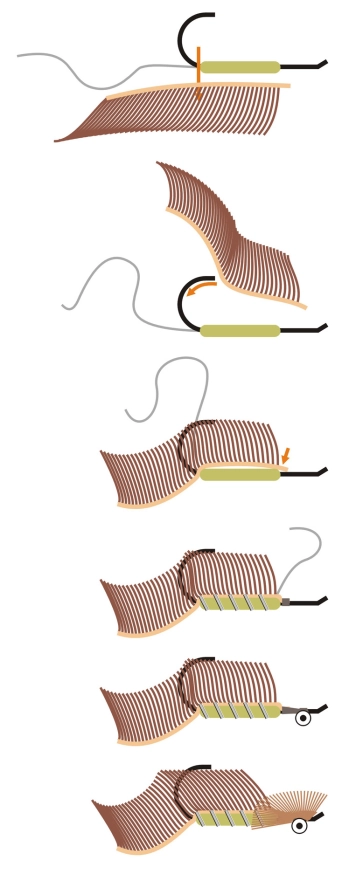


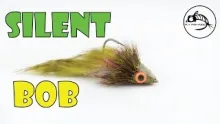

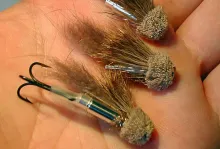

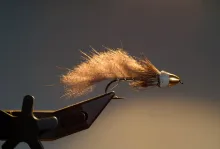

Thank you for the wo
Thank you for the wonderful work. Zonker is always a good choice--practically at any time.
I appreciate all the work you have put into this great "teaching" site.
Mike,
Glad you li
Mike,
Glad you like the fly and had luck with it. It's been a while since I fished it last, but your comment may just get me cranking out a few for this upcoming season's fishing... And yes, Steve's Universal Nymph is a killer fly!
Martin
Used a varation of t
Used a varation of this fly on a local bass lake and was rewarded with a nice 2 # large mouth use tan and shrimp u-v ice dub for the body and got a very flashy fly that i thinks hold geat promise for many warm and cold water species cant wait to try it on trout and stripers.I live in Atlanta Ga. by the way and we have acess to tailwater trout and many warm water species.Thanks for this site I also got my top producing trout nymph (unirversal nymph) from you guys. thanks again.